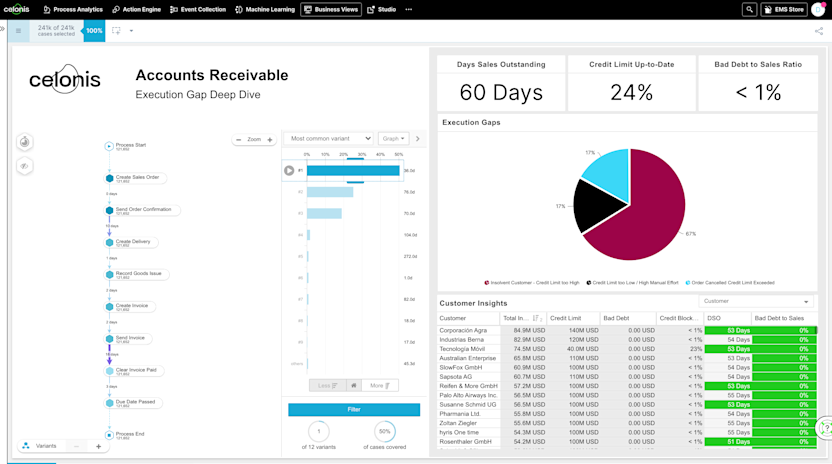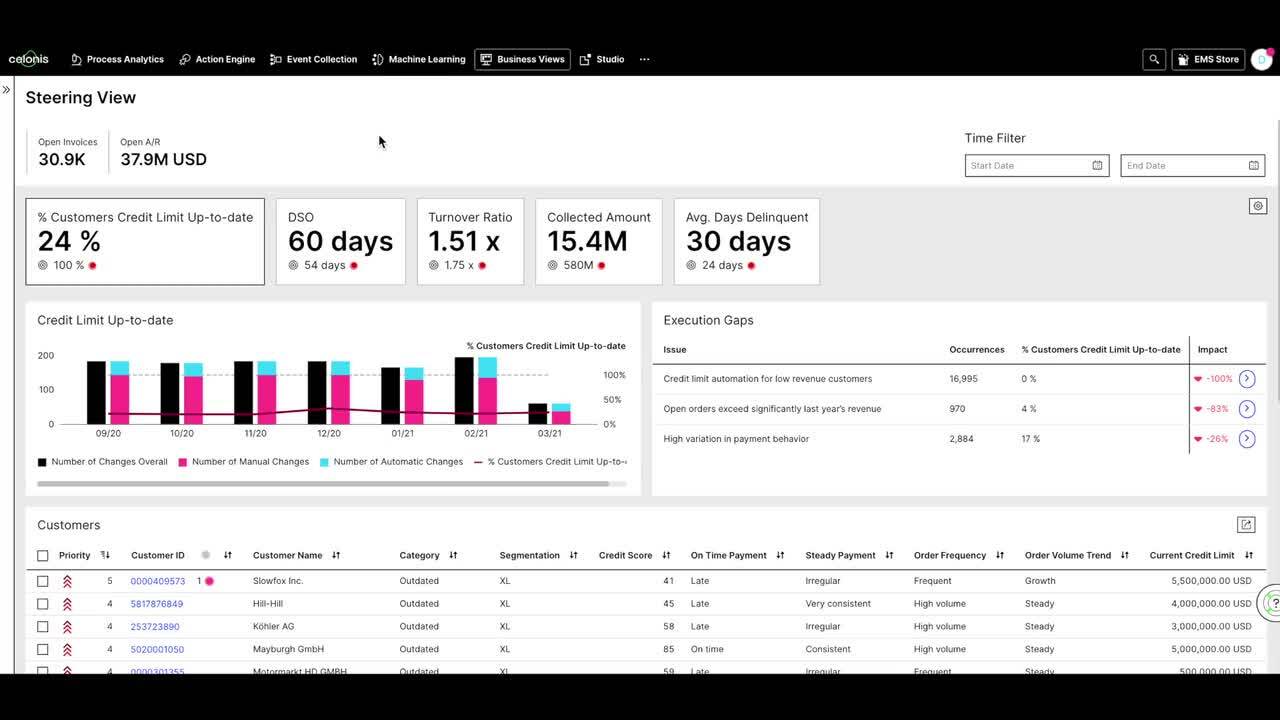
What is Accounts Receivable? The process, KPIs and metrics that matter
Accounts Receivable is a critical business function and plays a key role in how companies manage their cash flow and working capital. Unfortunately, many organizations are leaving cash on the table as a result of significant execution gaps in their accounts receivable process
According to the J.P. Morgan Working Capital Index Report 2022, the S&P 1,500 companies could have freed up an estimated $523B (US) in total working capital by the end of 2021 had they improved their performance against several accounts receivables and accounts payable KPIs. Citing data from S&P Capital IQ, J.P. Morgan also found that the average company has an average sales outstanding of 49.4 days, while top performers clocked in at 26.7 days.
Here, we’ll examine the Accounts Receivable process, how it’s different from Accounts Payable, important metrics and business objectives. We’ll also look at how companies are optimizing Accounts Receivable with new technologies, such as automation, process mining and execution management.
Understanding Accounts Receivable (AR)?
Accounts Receivable (AR or A/R), sometimes called “receivables,” is how companies ensure, receive and process customer payments. In general accounting, Accounts Receivable is the money owed to a business for goods and services delivered but not yet paid for, i.e. purchased by customers on credit. After the sale is made and products are delivered, AR sends the invoice and processes the customer payment.
Accounts Receivables appear on a company’s balance sheet as a short-term asset, as they will generally be converted to cash within a year of the initial transaction. There is no definitive timeframe for payment after the goods/services are delivered, but periods of 30, 60 or 90 days are common.
The number of days a customer has to pay the amount owed is usually specified on the invoice using terms like, Net 30, Net 60 or Net 90. Businesses may offer a cash discount to customers for paying early. For example, a business that specifies “2/10 Net 30” terms on their invoices is offering a 2% discount off the invoice’s total amount if paid within 10 days. Otherwise, 100% of the total is due within 30 days.
Because the customer (or debtor) has a legal obligation to pay for what they received, Accounts Receivables are considered a liquid asset. Through a process called “pledging,” businesses can even use their Accounts Receivable as collateral for a short-term or long-term loan or line of credit.
Like Accounts Payable, Procurement and even IT, Accounts Receivable has long been considered a cost center, i.e. a central service or back office process that’s necessary but doesn’t drive revenue. In reality, AR is a tool for improving cash flow, which is critical during boom times when you need to quickly fund new opportunities or during downturns when we need to preserve cash to survive.
What is the Accounts Receivable process?
Accounts Receivable sits within the Order-to-Cash (O2C) business process after Order Management. Within the broader business process landscape, AR is the final step in the Lead-to-Cash process coming after Lead-to-Opportunity, Opportunity Management, Quote-to-Order, and Order Management.

Celonis for Account Receivable Starter Kit
The O2C process The AR process itself contains the following steps in order:
Issue invoice
Ensure payment
Process payment
How is Accounts Receivable different from Accounts Payable?
Accounts Payable (AP or A/R), sometimes called “payables,” is the amount of money a business owes goods or services it receives on credit from a vendor. Accounts Payable is considered a current liability on a corporate balance sheet, whereas Accounts Receivable is a current asset. Like AP, the AR team is generally located within the Finance department.
Download Celonis EMS Accounts Receivable Execution App Data SheetWhat are the business objectives of Accounts Receivable?
AR departments exist to ensure that customers pay for the goods and services that are delivered, that the company actually receives those incoming payments and that the payments are processed quickly and accurately.
AR staff can improve cash control by focusing on the following business objectives:
Revenue Protection
Working Capital Optimization
Labor Productivity
Compliance and Risk Management
Companies are improving working capital, mitigating risk and reducing costs by using technologies like Process Mining, artificial intelligence, machine learning and automation to transform their accounts receivable process.
By reducing underpayments and uncollectible invoices, AR teams can improve revenue protection. They can optimize working capital by reducing late billings and late payments. Labor productivity can be improved by reducing invoice errors, disputes and rejections. And, AR staff can ensure compliance and mitigate risk through better fraud detection and maintaining internal controls.

What are Accounts Receivable metrics and KPIs?
There are various metrics, or key performance indicators (KPIs), companies track to determine whether Accounts Receivable is achieving core business objectives. The following are common AR metrics that fall under each of the business objectives listed above and include:
Days Sales Outstanding (DSO)
Invoices per FTE (Cost per invoice)
Revenue Leakage
Bad Debt to Sales Ratio
Collection Effectiveness Index
Average Days Delinquent
Accounts Receivable Turnover Ratio
AR teams can improve their performance for these and other key accounts receivable metrics by using automation, Process Mining and Execution Management to increase driver KPIs like the touchless invoice rate and first time right rate, reduce measures like the late payment rate and average days delinquent.
As noted above, there are often large execution gaps between average companies and the most efficient organizations for these metrics. For example, according to Celonis’ 2021 State of Business Execution Benchmarks Report, the average company has a Collection Effectiveness Index of 56.6%, while top performers hit 83.6%. Best-in-class companies have an Accounts Receivable Turnover Ratio of 57, with average businesses seeing a ratio of only 15. Leading organizations have an Average Days Delinquent number of 8 days, while average companies have a number more than 3x that at 29.9 days.
More Accounts Receivable resources | More Accounts Payable resources
What use cases are deployed by Accounts Receivable Improvement teams?
There are multiple business use cases to optimize AR operations, but here are five that businesses such as PepsiCo, Mars, Sysmex, 3M and Ascend Performance Materials have used:
Ensure on-time payment. Customers often pay after the invoice due date. Unfortunately, it can be difficult to anticipate payment issues, non-payments or late payments. If you only react after the payment is missed, you could be leaving money on the table in that accounting cycle. With the right processes and technology however, companies can accelerate customer payments by more intelligently targeting dunning. Using an execution management system (EMS), organizations can engage customers through data-driven prioritization, more effectively resolve disputes and impose late payment penalties for non-strategic customers.
Increase touchless collections. The Accounts Receivable process often involves a range of manual tasks, those manual actions both create costs and decrease collector effectiveness. By automating more of the AR process and thus reducing manual effort, companies can improve collector effectiveness and accelerate collections. Process mining, execution management and automation technologies enable businesses to monitor the automation rate of individual activities, enact automated dunning strategies and automatically resolve root cases that lead to manual activity such as missing invoice details or invoice errors.
Track payment term compliance. Too often invoices don’t use the best available payment terms from the sales order, master data or historic invoices. It’s also not uncommon for invoices to be sent with incorrect terms, e.g. failing to include contract changes. Accounts Payable departments should ensure that invoices always use the best possible payment terms. With execution management technology, organizations can identify the root causes for suboptimal payment terms, such as outdated master data. An EMS can then then flag invoices with incorrect terms and automatically suggest and set a better payment term within an invoice.
Prevent underpayments. When customers pay less than what they owe, receive a cash discount they aren’t entitled to or receive a higher cash discount than they should, you have an underpayments problem. Part of Accounts Receivable’s job is to ensure that customers always pay the full invoice amount and stop customers from receiving incorrect cash discounts. An EMS gives AR organizations full visibility into which customers aren’t paying their full invoices and allows them to reclaim missing payments and unjustified cash discounts.
Improve credit utilization. Manually tracking credit utilization is a cumbersome process, requiring involvement from multiple stakeholders. Credit reviews are time consuming, and unnecessary credit holds cause function and risk lost revenue. Risk assessments can be labor-intensive and create blind spots for the AR team. With the right systems however, companies can track credit utilization efficiently across their customer base and intelligently assess risk and update credit limits. Using EMS, Accounts Receivable staff can assess credit risk in real-time and design limits to adjust automatically. They can leverage intelligent credit limit suggestions and access all relevant data in a single place, while using automation to accelerate the approval process. An EMS can pull data from across your underlying systems, including your accounting software, as well as integrate third-party and custom data from standard credit bureaus and a company’s own scorecards.
What are the biggest Accounts Receivable challenges?
In the Fall of 2020 when the data for our 2021 State of Business Execution Benchmarks Report was compiled, the Covid-19 pandemic was raging and Accounts Receivable leaders were under pressure to improve cash control and maintain essential cash reserves. Those pressures have only intensified with the dramatic rise in inflation that followed and a looming global recession.
In the report, Celonis identified three of the biggest challenges facing Accounts Receivable, and they hold true now, just as they did in then:
Managing risk in a time of crisis: Risk management during times of economic uncertainty means AR leaders need to de-risk their AR processes and “reduce the number of unrecovered Accounts Receivable.”
Evolving from reactive to proactive: Waiting for customer invoices to go unpaid before taking action prevents Accounts Receivable from operating at peak performance and costs your business money. To ensure optimal AR operations, the report’s authors insist that AR teams “make better use of their data to change the way they prioritize accounts before they ever become overdue, taking a proactive approach to collections.”
Identifying the customers most likely to pay: Optimizing collections means going beyond basic AR KPIs like DSO and developing a more comprehensive picture of likelihood to pay. Leading AR departments are using technologies like process mining, artificial intelligence and machine learning to better identify which customers are likely to pay and thus target collectors time more effectively.
Related reading:



